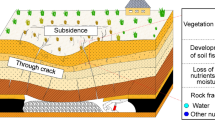Abstract
In this study, the variations of the temperatures and volumetric unfrozen water contents for two fine-grained soils (i.e., silty clay and silt) with high degrees of saturation during a freezing–thawing process were experimentally studied. Experimental results show that for the two soils, the supercooling phenomenon only happens in the early stage of freezing process, and the supercooling temperature and its duration of the silty clay are both larger than those of the silt under similar temperatures; furthermore, the hysteresis effect of volumetric unfrozen water content exists during the whole freezing–thawing process, and the maximum hysteresis levels both occur at the soil freezing points; however, the maximum value of the hysteresis level of the silt is larger than that of the silty clay.








Similar content being viewed by others
References
Anderson DM (1967) Ice nucleation and the substrate–ice interface. Nature 216:563–566
Anderson DM, Tice AR (1973) The unfrozen interfacial phases in frozen soil water systems. Ecological studies 4: physical aspects of soil water and salts in ecosystems. Springer, Berlin, Heidelberg, pp 107–124
Ayers AD, Campbell RB (1951) Freezing point of water in a soil as related to salt and moisture contents of the soil. Soil Sci 72(3):201–206
Bittelli M, Flury M, Campbell GS (2003) A thermodielectric analyzer to measure the freezing and moisture characteristic of porous media. Water Resour Res 39(2):1041
Black PB, Miller RD (1990) Hydraulic conductivity and unfrozen water content of air-free frozen silt. Water Resour Res 26(2):323–329
Chen S-L, Lee T-S (1998) A study of supercooling phenomenon and freezing probability of water inside horizontal cylinders. Int J Heat Mass Transf 41(4–5):769–783
Dillon HB, Andersland OB (1966) Predicting unfrozen water contents in frozen soils. Can Geotech J 3(2):53–60
Fabbri A, Fen-Chong T, Azouni A, Thimus J (2009) Investigation of water to ice phase change in porous media by ultrasonic and dielectric measurements. J Cold Reg Eng 23(2):69–90
Harrysson Drotz S, Tilston EL, Sparrman T, Schleucher J, Nilsson M, Öquist MG (2009) Contributions of matric and osmotic potentials to the unfrozen water content of frozen soils. Geoderma 148(3–4):392–398
Homshaw LG (1981) Supercooling and pore size distribution in water-saturated porous materials: application to study of pore form. J Colloid Interface Sci 84(1):141–148
Jackson KA, Chalmers B (1958) Freezing of liquids in porous media with special reference to frost heave in soils. J Appl Phys 29(8):1178–1181
Kelleners TJ, Norto JB (2012) Determining water retention in seasonally frozen soils using hydra impedance sensors. Soil Sci Soc Am J 76(1):36–50
Kozlowski T (2004) Soil freezing point as obtained on melting. Cold Reg Sci Technol 38(2–3):93–101
Kozlowski T (2009) Some factors affecting supercooling and the equilibrium freezing point in soil–water systems. Cold Reg Sci Technol 59(1):25–33
Lai YM, Zhang MY, Li SY (2009) Theory and application of cold regions engineering. Science Press, Beijing
Mishima O, Stanley HE (1998) The relationship between liquid, supercooled and glassy water. Nature 396:329–335
Nagare RM, Schincariol RA, Quinton WL, Hayashi M (2012) Effects of freezing on soil temperature, freezing front propagation and moisture redistribution in peat: laboratory investigations. Hydrol Earth Syst Sci 16(2):501–515
Patterson DE, Smith MW (1980) The use of time domain reflectometry for the measurement of unfrozen water content in frozen soils. Cold Reg Sci Technol 3(2–3):205–210
Qin YH, Li GY, Qu GZ (2009) A formula for the unfrozen water content and temperature of frozen soils. In: Cold regions engineering 2009 (proceedings of the 14th conference on cold regions engineering), Duluth, MN, USA, pp 155–161
Shaw TM (1942) A method of minimizing supercooling and its application in the determination of freezing points from dielectric constant measurements. Rev Sci Instrum 13:2–5
Spaans EJA, Baker JM (1996) The soil freezing characteristic: its measurement and similarity to the soil moisture characteristic. Soil Sci Soc Am J 60(1):13–19
Tian HH, Wei CF, Wei HZ, Zhou JZ (2014) Freezing and thawing characteristics of frozen soils: bound water content and hysteresis phenomenon. Cold Reg Sci Technol 103:74–81
Tice AR, Anderson DM, Sterrett KF (1981) Unfrozen water contents of submarine permafrost determined by nuclear magnetic resonance. Eng Geol 18(1):135–146
Wan XS, Lai YM, Wang C (2015) Experimental study on the freezing temperatures of saline silty soils. Permafr Periglac Processes 26(2):175–187
Watanabe K, Mizoguchi M (2002) Amount of unfrozen water in frozen porous media saturated with solution. Cold Reg Sci Technol 34(2):103–110
Xu XZ, Wang JC, Zhang LX (2010) Frozen soil physics. Science Press, Beijing
Zhou M-M, Meschke G (2018) A multiscale homogenization model for strength predictions of fully and partially frozen soils. Acta Geotech 13(1):175–193
Zhou YW, Guo DX, Qiu GQ, Cheng GD, Li SD (2000) Geocryology in China. Science Press, Beijing
Acknowledgements
This research was supported by the National Natural Science Foundation of China (Grant No. 41471063), the National Key Research and Development Program of China (Grant No. 2018YFC0809605), the Program of the State Key Laboratory of Frozen Soil Engineering (Grant No. SKLFSE-ZT-23), the Key Research Program of Frontier Sciences of Chinese Academy of Sciences (Grant No. QYZDY-SSW-DQC015), and the Natural Science Foundation of Gansu Province of China (Grant No. 1508RJZA100).
Author information
Authors and Affiliations
Corresponding author
Additional information
Publisher's Note
Springer Nature remains neutral with regard to jurisdictional claims in published maps and institutional affiliations.
Rights and permissions
About this article
Cite this article
Zhang, M., Zhang, X., Lai, Y. et al. Variations of the temperatures and volumetric unfrozen water contents of fine-grained soils during a freezing–thawing process. Acta Geotech. 15, 595–601 (2020). https://doi.org/10.1007/s11440-018-0720-z
Received:
Accepted:
Published:
Issue Date:
DOI: https://doi.org/10.1007/s11440-018-0720-z




